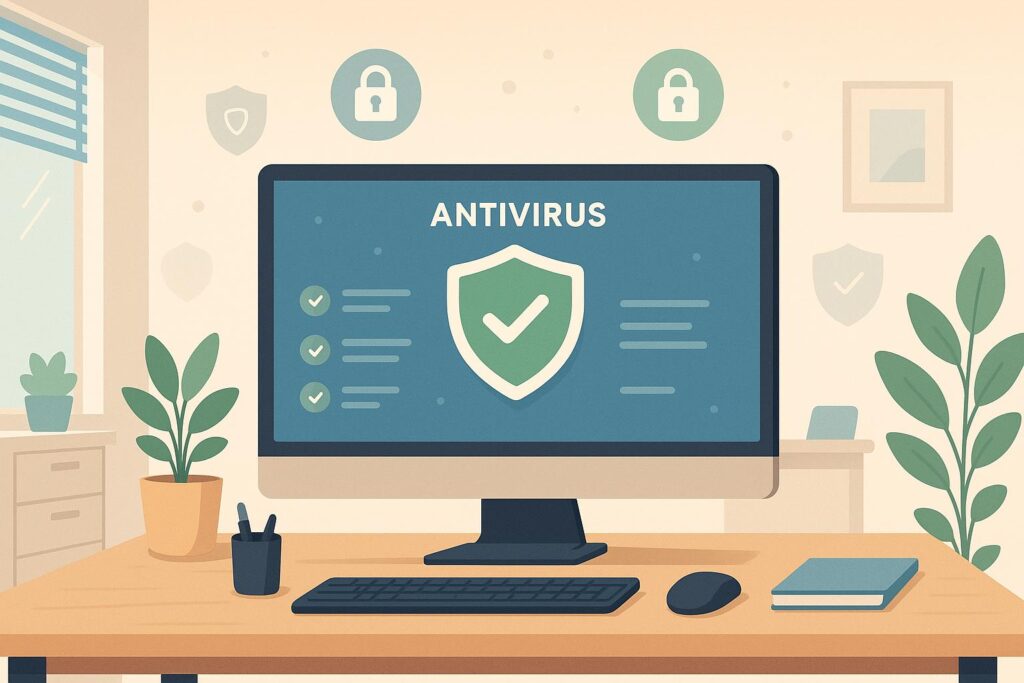Antivirus setup mistakes can leave your business vulnerable to cyber threats. Here are the top 5 issues and how to fix them:
-
Software Compatibility Problems
- Antivirus may block essential apps like email or point-of-sale systems.
- Fix: Test antivirus with your business software and adjust settings for trusted apps.
-
License Management Errors
- Expired or mismatched licenses can leave devices unprotected.
- Fix: Track licenses centrally and set renewal reminders.
-
Incorrect Settings and Policies
- Poor configurations can create security gaps or disrupt operations.
- Fix: Regularly review and adjust antivirus settings.
-
Outdated Software
- Old versions miss new threats and slow down systems.
- Fix: Enable automatic updates and monitor patching schedules.
-
System Slowdowns and False Alerts
- Misconfigured antivirus can cause lags and unnecessary warnings.
- Fix: Optimize scan settings and schedule tasks during off-peak hours.
Pro Tip: If managing antivirus feels overwhelming, consider hiring IT professionals to handle setup, updates, and monitoring for you.
How Do I Choose The Right Antivirus For My Small Business …
1. Software Compatibility Issues
When antivirus software clashes with essential applications, it can disrupt daily operations and productivity.
Common Problems
- Business software mistakenly flagged as a threat
- Database connections failing or timing out
- Email clients struggling to sync properly
- Cloud storage access being blocked
- Point-of-sale systems experiencing interruptions
These kinds of conflicts can significantly impact workflow, making it crucial to address them effectively.
How to Prevent Issues
Before rolling out antivirus software, create a detailed inventory of your business applications. Then, test the antivirus in a controlled setup to identify any potential conflicts early on.
"We keep your info private and secure with top-level protection and protocols." – Computer Mechanics Perth [1]
Stay Ahead with Real-Time Monitoring
Keeping antivirus software updated is key to maintaining compatibility with evolving applications. Regularly check application performance, resource usage, error logs, and network stability to catch and resolve issues quickly.
Optimize Your Configuration
Adjust antivirus settings to strike a balance between security and functionality. For instance, set exceptions for trusted applications to avoid unnecessary disruptions. Without these adjustments, restrictive settings could block critical operations, like accounting software accessing secure databases for financial tasks.
When problems persist, consulting IT professionals may be the best route to ensure smooth operations.
2. License Management Problems
Keeping track of antivirus licenses is essential to ensure your systems stay protected. Small businesses often struggle with this, leaving them exposed to risks.
Common License Issues
Here are two key challenges businesses face:
- Expired licenses: Without proper monitoring, licenses can lapse, leaving systems unprotected.
- Mismatched seat counts: When the number of licenses doesn’t align with the devices in use, some systems may lack coverage.
Setting Up License Tracking
To avoid these problems, create a centralized system to manage your antivirus licenses. Keep a record of important details like:
- Expiration dates
- The number of devices covered by each license
Smart License Management
Automate reminders for upcoming license renewals. This helps you stay ahead of potential issues and ensures your antivirus protection remains effective.
Cost-Effective Solutions
- Regularly audit your licenses to confirm they match the number of devices in use.
- Schedule renewal reminders to prevent lapses in coverage.
3. Wrong Settings and Policies
Incorrect antivirus settings can expose systems to risks and even disrupt normal operations. To ensure strong security, it’s crucial to review configurations regularly and adjust them as needed. Next, let’s look at how outdated software and missed updates can weaken your system’s defenses.
4. Missing Updates and Old Software
Using outdated antivirus software weakens your system’s defenses. Without up-to-date virus definitions and security patches, your business is more susceptible to emerging threats.
Security Risks
Old software struggles to identify newer malware, leaving your systems open to attacks that modern solutions could block.
Performance Issues
Running older antivirus versions can bog down your systems. You might experience slower performance, application crashes, delayed threat detection, or incomplete scans. These issues, combined with configuration and licensing challenges, highlight the need for consistent updates.
Managing Updates Effectively
To keep your antivirus software current without disrupting your workflow, consider these steps:
- Schedule automated updates during off-hours.
- Update virus definitions daily.
- Check for software version updates weekly.
- Conduct monthly security audits.
If your small business doesn’t have a dedicated IT team, outsourcing to a managed IT service could be a practical solution. For example, Computer Mechanics Perth offers services designed to handle updates and monitor systems proactively, making it easier for small businesses to stay secure.
Practical Tips
Turn on automatic updates and plan for occasional manual checks. Set up system alerts to notify key team members if updates fail or are missed. This extra layer of monitoring can help prevent gaps in your security.
Next, we’ll explore how system slowdowns and false alerts can affect your operations.
"We keep your info private and secure with top-level protection and protocols." – Computer Mechanics Perth [1]
sbb-itb-078dd21
5. System Slowdowns and False Alerts
Misconfigured antivirus software can lead to sluggish system performance and false alerts, both of which can disrupt business operations.
Impact on System Performance
Antivirus programs can put a strain on your system in several ways:
- Real-time scanning consumes CPU and memory resources.
- Background updates can slow down your internet connection.
- Full system scans may temporarily make your computer unresponsive.
- Running multiple security features at once can overload system resources.
Fine-tuning your antivirus settings can help reduce these issues and keep your system running smoothly.
Managing False Alerts
False positives – when legitimate files are flagged as threats – can interrupt workflows and cause unnecessary delays. To minimize these interruptions while maintaining security, try these strategies:
- Schedule Resource-Intensive Tasks: Configure scans and updates to run during off-peak hours, such as between 7:00 PM and 5:00 AM. This ensures productivity isn’t affected during busy times.
- Optimize Scan Settings: Exclude trusted business applications and frequently accessed folders from scans. This reduces system strain without compromising security.
- Monitor System Resources: Keep an eye on how much CPU and memory your antivirus is using. If performance issues persist, consider adjusting settings or consulting with IT professionals.
Professional Management Benefits
For a more streamlined approach, managed IT services can help. They offer proactive monitoring, expert configuration, and performance tuning to ensure your antivirus software protects your business without slowing it down.
Computer Mechanics Perth provides managed IT services designed to balance security and performance. Their team ensures your antivirus solution works effectively without becoming a barrier to daily operations.
Fix These Setup Problems
Address antivirus setup challenges by ensuring it works well with your system and keeping licenses organized.
Checking Software Compatibility
Before rolling out antivirus software across your network, test it on a less critical device. This helps confirm it works smoothly with your hardware and software. It’s a simple way to avoid potential disruptions.
Managing Licenses Effectively
Keep all your antivirus licenses in one place to make tracking easier. Regularly check renewal dates to ensure your devices stay protected without interruptions.
Getting Expert IT Help
Once you’ve tackled setup challenges, bringing in IT experts can strengthen your antivirus approach. Setting up and managing antivirus systems requires specialized knowledge to avoid costly mistakes.
Partnering with IT professionals helps small businesses address common setup issues and maintain strong antivirus protection.
Why Choose Professional Antivirus Management?
IT service providers offer critical support, including:
- System Protection: Ongoing monitoring and timely updates to keep your systems safe.
- Policy Management: Tailored security policies designed to fit your business requirements.
- License Management: Tracking licenses and sending automated renewal reminders.
- Performance Optimization: Adjusting settings to balance security and system efficiency.
How Managed IT Services Work
Managed IT services eliminate the need for an in-house IT team while providing top-tier protection. Here’s what a managed service provider typically handles:
| Service Area | What It Includes |
|---|---|
| Initial Setup | Expert configuration, network integration, and compatibility testing. |
| Ongoing Management | Regular updates, maintenance, and adjustments to security policies. |
| Issue Resolution | Quick responses to alerts, malware removal, and system recovery. |
| Security Monitoring | Around-the-clock threat detection, automated scans, and real-time protection. |
This organized approach not only safeguards your network but also keeps costs manageable.
Affordable and Predictable Costs
Managed IT services provide consistent monthly pricing, which often includes:
- Regular system check-ups.
- On-demand support when you need it.
- Continuous security management to ensure your systems stay protected.
Conclusion
Tackling common setup issues is key to building a strong line of defense against cyber threats. Configuring your antivirus correctly plays a crucial role in protecting your business from ever-changing risks.
Here are some essential steps to maintain effective antivirus protection:
- Regularly update and check compatibility to prevent software conflicts.
- Manage licenses carefully to avoid lapses in coverage.
- Configure security policies to match your business requirements.
- Monitor system performance to strike a balance between security and efficiency.
- Work with IT professionals for dependable antivirus management.
Collaborating with IT specialists, like the team at Computer Mechanics Perth, can help ensure your antivirus solution is ready to handle new security challenges. Whether managed in-house or with expert assistance, regular reviews and updates to your antivirus setup will keep your systems secure and operating smoothly. Stay proactive to outpace evolving threats.
FAQs
What steps can small businesses take to ensure their antivirus software works smoothly with critical applications?
To ensure your antivirus software remains compatible with essential business applications, start by verifying system requirements before installation. Check that both the antivirus and your applications support the same operating system and version. Regular updates are also critical – keep both your antivirus software and applications up to date to avoid potential conflicts caused by outdated versions.
Additionally, configure your antivirus settings carefully to prevent it from mistakenly flagging or blocking necessary programs. Many antivirus solutions allow you to create exceptions for trusted applications. If you’re unsure about setup or encounter persistent issues, consulting with IT professionals, like those at Computer Mechanics Perth, can help ensure a seamless deployment and ongoing compatibility.
How can small businesses effectively manage antivirus licenses to ensure consistent protection?
Managing antivirus licenses effectively is crucial to maintaining uninterrupted protection for your business. Here are some key strategies to help:
- Centralize license management: Use a dedicated tool or portal to track all your antivirus licenses. This can help you monitor expiration dates, renewals, and usage across devices.
- Set up renewal reminders: Schedule alerts well before licenses expire to avoid lapses in coverage. Automating renewals where possible can also save time and reduce the risk of oversight.
- Opt for multi-device or business plans: These plans often simplify license management by covering multiple devices under a single account, which can also reduce costs.
By staying proactive and organized, small businesses can ensure their antivirus software remains up to date, providing continuous protection against cyber threats.
How can small businesses adjust antivirus settings to prevent system slowdowns and reduce false alerts?
To optimize your antivirus settings and avoid system slowdowns or false alerts, small businesses should focus on a few key adjustments:
- Customize scanning schedules: Schedule full system scans during off-hours to minimize disruptions during work hours.
- Adjust sensitivity settings: Lower the sensitivity for detecting potential threats if false alerts are frequent, but ensure critical protections remain active.
- Whitelist trusted applications: Add commonly used and safe software to the antivirus whitelist to prevent unnecessary scanning or blocking.
Additionally, keeping your antivirus software up to date and ensuring it’s properly configured for your business needs can significantly improve performance. If you encounter persistent issues, consulting professionals like Computer Mechanics Perth can help fine-tune your cybersecurity setup and ensure smooth operations.

